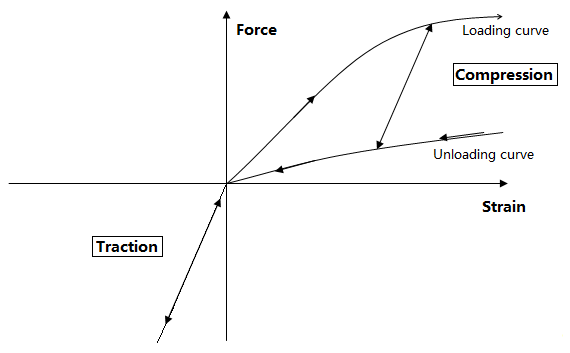Block Format Keyword
/PROP/TYPE26 - Tabulated Spring Property Set
Description
Defines the tabulated spring property.
Format
(1)
|
(2)
|
(3)
|
(4)
|
(5)
|
(6)
|
(7)
|
(8)
|
(9)
|
(10)
|
/PROP/TYPE26/prop_ID/unit_ID or /PROP/SPR_TAB/prop_ID/unit_ID
|
prop_title
|
M
|
|
|
|
sens_ID
|
Isflag
|
Ileng
|
|
|
Nfunc
|
Nfund
|
Lscale
|
Kmax
|
|
Alpha
|
Loading function cards (Nfunc)
(1)
|
(2)
|
(3)
|
(4)
|
(5)
|
(6)
|
(7)
|
(8)
|
(9)
|
(10)
|
fct_ID1
|
Fscale
|
Strain_rate
|
|
|
|
Unloading function cards (Nfund)
(1)
|
(2)
|
(3)
|
(4)
|
(5)
|
(6)
|
(7)
|
(8)
|
(9)
|
(10)
|
fct_ID1
|
Fscale
|
Strain_rate
|
|
|
|
Field
|
Contents
|
SI Unit Example
|
prop_ID
|
Property identifier
(Integer, maximum 10 digits)
|
|
unit_ID
|
Optional unit identifier
(Integer, maximum 10 digits)
|
|
prop_title
|
Property title
(Character, maximum 100 characters)
|
|
M
|
Mass or Mass divided by L0 depending on flag Ileng (Comments 6 and 7)
(Real)
|
 or or 
|
sens_ID
|
Sensor identifier
(Integer)
|
|
Isflag
|
Sensor flag
(Integer)
=0: spring element activated (Comment 2)
=1: spring element deactivated (Comment 3)
=2: spring element activated or deactivated (Comment 4)
|
|
Ileng
|
Input per unit length flag
(Integer)
= 0: See Comment 6
= 1: See Comment 7
|
|
Nfunc
|
Numbers of loading curves
(Integer)
|
|
Nfund
|
Numbers of unloading curves
(Integer)
|
|
Lscale
|
Scale factor for abscissa of loading and unloading functions (Comment 9)
Default = 1 (Real)
|
|
Kmax
|
Maximum Stiffness or Stiffness multiply with L0 depending on flag Ileng
(Real)
|
 or or 
|
Alpha
|
Strain rate filtering factor
Authorized values between 0.0 and 1.0.
Default value = 1.0 (no strain filtering)
(Real)
|
|
fct_ID1
|
Function identifier defining  or or  depending on flag Ileng (Comments 6 and 7) depending on flag Ileng (Comments 6 and 7)
(Integer)
|
|
Fscale
|
Scale factor for loading and unloading functions
(Real)
|

|
Strain_rate
|
 or or  corresponding to a loading or unloading function corresponding to a loading or unloading function
(Real)
|

|
|
| 1. | Let  be the difference between the current length and the initial length L0 of the spring element. be the difference between the current length and the initial length L0 of the spring element. |
| 2. | If sens_ID ≠ 0 and Isflag = 0, the spring element is activated by the sens_ID. |
| 3. | If sens_ID ≠ 0 and Isflag = 1, the spring element is deactivated by the sens_ID. |
| 4. | If sens_ID ≠ 0 and Isflag = 2, then: |
| • | The spring is activated and/or deactivated by sens_ID
(if sensor is ON, spring is ON; if sensor is OFF, spring is OFF). |
| • | The spring reference length (L0) is the distance between the two extremities at sensor’s activation. |
| 5. | If a sensor is used for activating or deactivating a spring, the reference length of the spring at sensor activation (or deactivation) is equal to the nodal distance at time =0; except if sensor flag is equal to 2. |
| 6. | In case of Ileng =0, the force is computed as  , if Ileng =1 , if Ileng =1 |
The force is 
Where,  is the engineering strain: is the engineering strain:

and L0 is the reference length of the element, with 
| 7. | If Ileng = 1, all input are per unit length: |
| • | Spring mass =  Spring stiffness = Spring stiffness = 
Where, L0 is the reference spring length. |
| 8. | Spring forces are calculated using loading and unloading functions for different strain rate. |
| • | Actual strain rate is determined and the maximum loading force as well as the minimum unloading force is determined by interpolation from the input curves. |
| • | The behavior between the loading and unloading curves is linear, using Kmax value as the spring stiffness. |
| • | For both loading and unloading, input curves should be defined in order of strictly increasing strain rate values. |
| • | To describe spring compression behavior, input curves Force(strain) should be strictly positive. |
| • | In traction, spring behavior is linear with stiffness equal to Kmax. |


| 9. | Lscale is used only when the Ileng =1 (abscissa unit is length); otherwise the default value = 1. |

|
See Also:
Material Compatibility
/TH/SPRING (Time history output)
/SPRING (Spring element definition)
Spring definition in Model Preparation in User's Guide







